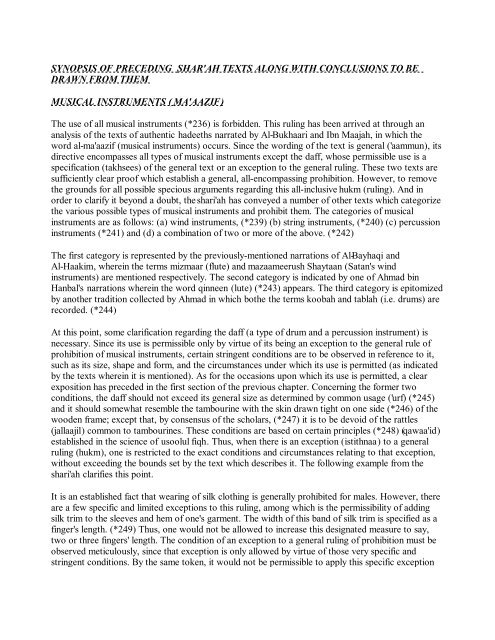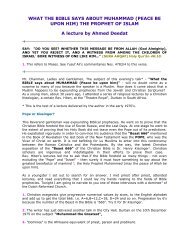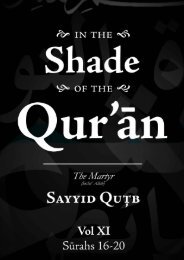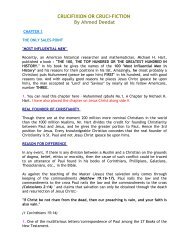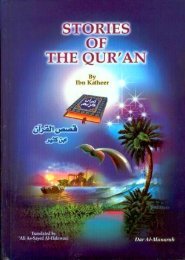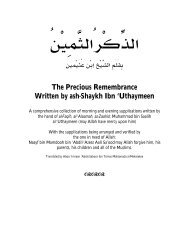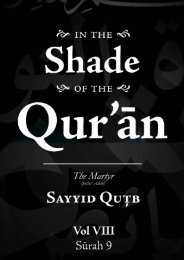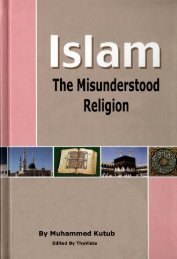The Islamic Ruling on Music and Singing - Enjoy Islam
The Islamic Ruling on Music and Singing - Enjoy Islam
The Islamic Ruling on Music and Singing - Enjoy Islam
Create successful ePaper yourself
Turn your PDF publications into a flip-book with our unique Google optimized e-Paper software.
SYNOPSIS OF PRECEDING SHAR'AH TEXTS ALONG WITH CONCLUSIONS TO BE<br />
DRAWN FROM THEM<br />
MUSICAL INSTRUMENTS ( MA'AAZIF)<br />
<str<strong>on</strong>g>The</str<strong>on</strong>g> use of all musical instruments (*236) is forbidden. This ruling has been arrived at through an<br />
analysis of the texts of authentic hadeeths narrated by Al-Bukhaari <strong>and</strong> Ibn Maajah, in which the<br />
word al-ma'aazif (musical instruments) occurs. Since the wording of the text is general ('aammun), its<br />
directive encompasses all types of musical instruments except the daff, whose permissible use is a<br />
specificati<strong>on</strong> (takhsees) of the general text or an excepti<strong>on</strong> to the general ruling. <str<strong>on</strong>g>The</str<strong>on</strong>g>se two texts are<br />
sufficiently clear proof which establish a general, all-encompassing prohibiti<strong>on</strong>. However, to remove<br />
the grounds for all possible specious arguments regarding this all-inclusive hukm (ruling). And in<br />
order to clarify it bey<strong>on</strong>d a doubt, the shari'ah has c<strong>on</strong>veyed a number of other texts which categorize<br />
the various possible types of musical instruments <strong>and</strong> prohibit them. <str<strong>on</strong>g>The</str<strong>on</strong>g> categories of musical<br />
instruments are as follows: (a) wind instruments, (*239) (b) string instruments, (*240) (c) percussi<strong>on</strong><br />
instruments (*241) <strong>and</strong> (d) a combinati<strong>on</strong> of two or more of the above. (*242)<br />
<str<strong>on</strong>g>The</str<strong>on</strong>g> first category is represented by the previously-menti<strong>on</strong>ed narrati<strong>on</strong>s of Al-Bayhaqi <strong>and</strong><br />
Al-Haakim, wherein the terms mizmaar (flute) <strong>and</strong> mazaameerush Shaytaan (Satan's wind<br />
instruments) are menti<strong>on</strong>ed respectively. <str<strong>on</strong>g>The</str<strong>on</strong>g> sec<strong>on</strong>d category is indicated by <strong>on</strong>e of Ahmad bin<br />
Hanbal's narrati<strong>on</strong>s wherein the word qinneen (lute) (*243) appears. <str<strong>on</strong>g>The</str<strong>on</strong>g> third category is epitomized<br />
by another traditi<strong>on</strong> collected by Ahmad in which bothe the terms koobah <strong>and</strong> tablah (i.e. drums) are<br />
recorded. (*244)<br />
At this point, some clarificati<strong>on</strong> regarding the daff (a type of drum <strong>and</strong> a percussi<strong>on</strong> instrument) is<br />
necessary. Since its use is permissible <strong>on</strong>ly by virtue of its being an excepti<strong>on</strong> to the general rule of<br />
prohibiti<strong>on</strong> of musical instruments, certain stringent c<strong>on</strong>diti<strong>on</strong>s are to be observed in reference to it,<br />
such as its size, shape <strong>and</strong> form, <strong>and</strong> the circumstances under which its use is permitted (as indicated<br />
by the texts wherein it is menti<strong>on</strong>ed). As for the occasi<strong>on</strong>s up<strong>on</strong> which its use is permitted, a clear<br />
expositi<strong>on</strong> has preceded in the first secti<strong>on</strong> of the previous chapter. C<strong>on</strong>cerning the former two<br />
c<strong>on</strong>diti<strong>on</strong>s, the daff should not exceed its general size as determined by comm<strong>on</strong> usage ('urf) (*245)<br />
<strong>and</strong> it should somewhat resemble the tambourine with the skin drawn tight <strong>on</strong> <strong>on</strong>e side (*246) of the<br />
wooden frame; except that, by c<strong>on</strong>sensus of the scholars, (*247) it is to be devoid of the rattles<br />
(jallaajil) comm<strong>on</strong> to tambourines. <str<strong>on</strong>g>The</str<strong>on</strong>g>se c<strong>on</strong>diti<strong>on</strong>s are based <strong>on</strong> certain principles (*248) (qawaa'id)<br />
established in the science of usoolul fiqh. Thus, when there is an excepti<strong>on</strong> (istithnaa) to a general<br />
ruling (hukm), <strong>on</strong>e is restricted to the exact c<strong>on</strong>diti<strong>on</strong>s <strong>and</strong> circumstances relating to that excepti<strong>on</strong>,<br />
without exceeding the bounds set by the text which describes it. <str<strong>on</strong>g>The</str<strong>on</strong>g> following example from the<br />
shari'ah clarifies this point.<br />
It is an established fact that wearing of silk clothing is generally prohibited for males. However, there<br />
are a few specific <strong>and</strong> limited excepti<strong>on</strong>s to this ruling, am<strong>on</strong>g which is the permissibility of adding<br />
silk trim to the sleeves <strong>and</strong> hem of <strong>on</strong>e's garment. <str<strong>on</strong>g>The</str<strong>on</strong>g> width of this b<strong>and</strong> of silk trim is specified as a<br />
finger's length. (*249) Thus, <strong>on</strong>e would not be allowed to increase this designated measure to say,<br />
two or three fingers' length. <str<strong>on</strong>g>The</str<strong>on</strong>g> c<strong>on</strong>diti<strong>on</strong> of an excepti<strong>on</strong> to a general ruling of prohibiti<strong>on</strong> must be<br />
observed meticulously, since that excepti<strong>on</strong> is <strong>on</strong>ly allowed by virtue of those very specific <strong>and</strong><br />
stringent c<strong>on</strong>diti<strong>on</strong>s. By the same token, it would not be permissible to apply this specific excepti<strong>on</strong>


